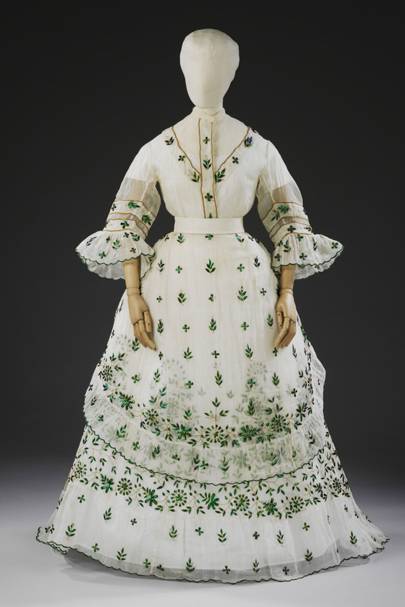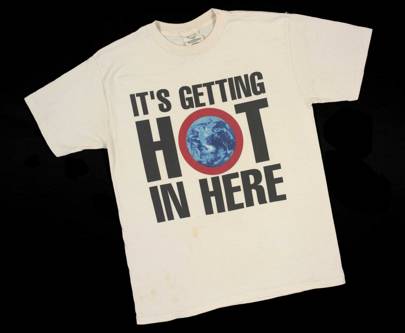Spanning 400 years, Fashioned From Nature, opening at the Victoria and Albert museum on April 21st, explores the garments and accessories that have been inspired by nature's awesome power and beauty throughout history but also investigates fashion's impact on the natural world and the devastating effects of manufacturing on our environment. Showcasing popular styles from as far back as the 17th century up to present day, the compelling and vital exhibition includes items such as an 1875 pair of earrings formed from the heads of two real Honeycreeper birds – a hugely popular item sold in enormous volume at the time – and an 1860s muslin dress decorated with over 5000 iridescent green wings pulled from live jewel beetles.
As you begin to walk around the exhibition, the sound of birdsong and animals in their natural habitat is intercepted by the sounds of man’s devastating impact on the planet with the din of heavy machinery and machetes cutting down trees. Similarly, the exhibition cases also become increasingly busy to reflect man’s insatiable demands on the natural world. “It’s all about production speeding up and our population growing incrementally,” Ehrman explains. “The cases will get crowded, too crowded sometimes.”
The exhibition moves through the 18th century, looking at the principle fibres i.e. flax, cotton, silk and wool as well as man's greedy use of feathers, furs and even bones. “Whalebone was a very important material used for lots of inner structure and through featuring [a section of a whale’s skeleton] we've tried to bring home the cruelty of whale fishing. It’s quite brutal really. Richard Sabin, who is an expert on whales at the Natural History Museum, has made a video for us.”

At the top of the stairs on the first floor, the dress worn by Emma Watson to the Met Gala 2016 stands on display amongst terrariums. “In collaboration with Calvin Klein, every part of the gown was produced with sustainability in mind - from the use of Newlife (a yarn made from post-consumer plastic bottles) to the zippers fashioned from recycled materials,” Watson explains in the foreword of the book that accompanies the exhibition. “The threads of this dress were woven in a reinvented tale of our consumption. We even designed different layers so that separate components could be worn again in different ways. I am proud of this dress."
"Clothes are something that touch our lives every day, and I admire the Victoria and Albert museum for creating this exhibition and book to highlight the importance of questioning where, how and by whom our clothes are made," Watson continues. "Regardless of social or economic status, we can all dress and shop more mindfully and sustainably. It is so important and timely that we now re-conceptualise what it means to wear and consume, and what is fashionable."
On display upstairs are more contemporary designs inspired from nature, such as a 2016 Giles Deacon haute-couture dress featuring a pattern of delicate bird eggs, and a 1997 Jean Paul Gaultier leopard print gown. Importantly, the exhibition also presents a range of solutions to reducing fashion’s impact on the environment from low water denim and the use of wild rubber to more conceptual and collaborative projects. A section on fashion protest highlights seminal designs from Vivienne Westwood and Katherine Hamnett alongside posters from sustainability campaigners, Fashion Revolution and, of course, pieces from sustainable pioneer Stella McCartney.

“We've really tried to find clothes that we as a team like because you’re not going to convert anybody unless these garments are fashionable and appealing to a wide range of tastes and incomes,” Ehrman explains. “I think my aim is that one day sustainability is no longer seen as something special. When I read that sustainability is the new luxury, I often think 'I don’t like that very much'. It shouldn’t be a luxury, it should be every day, it should be absolutely hotwired right from the very, very beginning.”
Interactive installations ‘Fashion Now’ and ‘Fashion Futures 2030’ have been curated by Professor Dilys Williams, an advisor to the whole exhibition and the Director of Centre for Sustainable Fashion at London College of Fashion which celebrates its 10th anniversary this year. “Doing the exhibition has been a big learning curve for me and I've learnt a huge amount. I'm technically a 19th century specialist, so I knew a lot about pollution but it’s been a real eye opener,” Ehrman confesses. “I think there’s a lot to surprise people [in this exhibition]. There’s so much interdisciplinary research going on between designers, technicians, scientists and a lot more sharing of information than I think we've had in the past. What we want is to inspire debate and discussion and to encourage people to find out more.”
This Sunday, the day after the exhibition officially opens to the public, the world celebrates Earth Day and then Monday 23rd April marks the fifth anniversary of the Rana Plaza factory collapse which killed and injured thousands of garment workers in 2013. The V&A’s essential exhibition couldn’t come at a better time when we should all be challenging brands and industry leaders to create clothes that are both beautiful and sustainable and striving to make more socially conscious decisions in terms of our wardrobes. Fashioned From Nature isn't just a captivating exhibition to get lost in for a few hours, but an urgent call to action to us all to readdress the way we think about fashion and more importantly our precious planet.

No comments:
Post a Comment